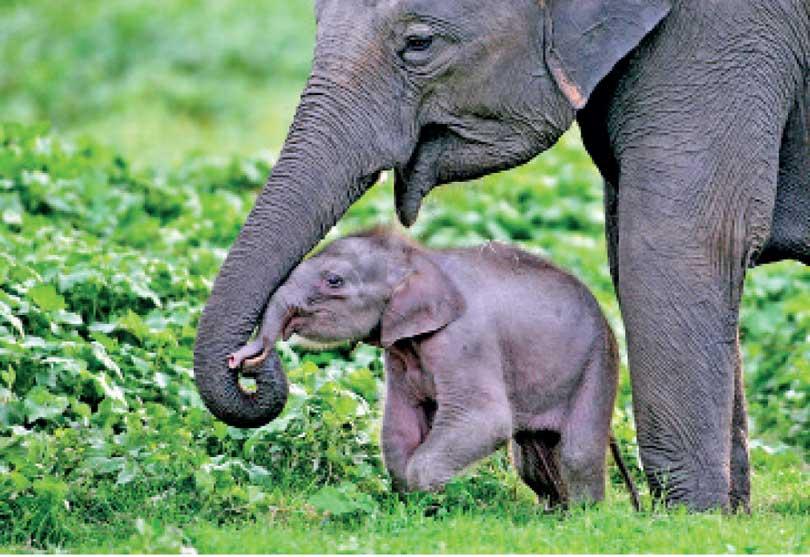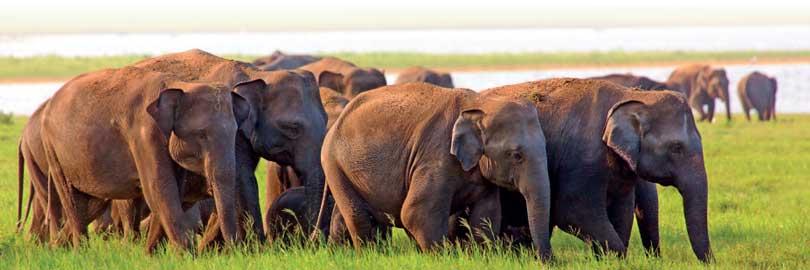13 Sep 2022 - {{hitsCtrl.values.hits}}

Minneriya Image by Gehan de Silva Wijeyeratne
Recent media reports have drawn attention to the plight of ‘The Gathering’, that iconic annual congregation of wild elephants in the Minneriya National Park; the largest conglomeration of Asian Elephants in any country that hosts this special species. As many are now aware, due to the unseasonal release of waters from Moragahakanda into Minneriya, these numbers have plummeted to barely 50 on any given day. More concerning from a conservation point of view is that the body condition of the elephants, particularly of the herds, has declined drastically, with evidence of elephant calves dying of malnutrition.
The problem has now been widely shared but the challenge remains over what is to be done to solve it and ensure the continuation of this valuable resource for the country, both in terms of conservation and economics. With this as the focus, on August 12, 2022, a special meeting of concerned conservation groups met to hear the problem from all sides of those involved. This meeting was facilitated by the Wildlife & Nature Protection Society (WNPS). It was hoped that a strategic group of representatives from like-minded organisations could be formed to tackle each of the problems and make appropriate proposals to the authorities for their resolution. There are now too many conservation concerns for one organisation to address them all. Cooperation is the need of the hour.
The water levels in Minneriya, which were gradually increasing from 2019, correlates with the reduction in elephant numbers during the ‘The Gathering’ months. With Minneriya being around 88% full in September 2021, the elephant numbers had reduced to a mere 20 elephants at the peak of the Gathering.
Presentations
Over 25 organisations participated online, and they were apprised of the current situation by Dr Sumith Pilapitiya, Dr Prithiviraj Fernando, Mr Srilal Miththapala, Mr D. Abeysiriwardena, Director of Irrigation, and Mr Dhanapala, Chair of the Water Management Committee. Several of the participants questioned why the statutory body for the conservation of wildlife in Sri Lanka, the Department of Wildlife Conservation (DWC) was not on the panel. They had been invited repeatedly over the weeks prior to the meeting but chose not to attend.
Dr Pilapitiya has been conducting research, since 2017, on the behaviour of elephants in the Minneriya & Kaudulla National Parks, and the Hurulu Eco Park, and it was he who first drew everyone’s attention to the alarming drop in numbers, since the release of unseasonal waters into the reservoir. In addition, even the elephants that were in the Park were in very poor body condition.

Minneriya Image by Dev Wijewardane
Dr Fernando is recognised as one of the leading researchers on Asian Elephants in the world, and he explained that this seasonal movement of elephants to Minneriya was primarily motivated by the need for food and not water. The records made by his organisation, the Centre for Conservation and Research (CCR), based on the collaring of selected animals from representative herds, confirmed that this movement, during the dry season, was in response to the receding waters of the Minneriya Tank exposing vast acres of grasslands, vital nutrients for these herds comprising mainly of females and young. The trouble with even a temporary cessation in this cycle is that elephants will seek fodder elsewhere, desperation driving them to look for it in adjacent human cultivations.
The problem has now been widely shared but the challenge remains over what is to be done to solve it and ensure the continuation of this valuable resource for the country, both in terms of conservation and economics.
A driver of the local economy
Mr Miththapala, the former President of the Tourist Hotels Association of Sri Lanka, presented the economic value of ‘The Gathering’ to the local and National economies. Its worldwide fame in attracting visitors to it, and they having to stay in the surrounding hotels and using the over 1,000 safari jeep drivers of the area, enriches the local communities and the country’s coffers with much-needed foreign exchange. In a study conducted by him in 2018, he calculated that the economic value of ‘The Gathering’ is worth a staggering $20 million (Rs. 3 billion) every year. Are we so rich a Nation to destroy it in such a short space of time?
The other side of the coin
The participation of Messrs. Abeysiriwardena and Dhanapala was greatly appreciated. Conservationists need to hear the other side of the story too, and the presentations made by these engineers did much to explain the pressures that they have to face. Their courage and honesty in presenting their side of the problem to what may have been a hostile audience was a credit to their dedication to their duty, and the commitment they have to the welfare of this country.
The engineers explained that the reason for using Minneriya as a holding tank for the excess waters released from the Moragahakanda Reservoir was to ensure that there would be sufficient water throughout the year to provide water for agriculture to the farmers of the North East. Eventually, when the canal systems that have been started in these areas are completed, then Minneriya will be bypassed and these waters sent directly there. Their graphs also showed that this excess water was sent to Minneriya mainly from 2019. The water levels in Minneriya, which were gradually increasing from 2019, correlates with the reduction in elephant numbers during the ‘The Gathering’ months. With Minneriya being around 88% full in September 2021, the elephant numbers had reduced to a mere 20 elephants at the peak of the Gathering.
There is always a way
In recognising the importance of ‘The Gathering’, and being sympathetic to the plight of the elephants there, perhaps the most important thing that the engineers had to say was that if the concerned statutory bodies meet regularly and discuss the problems each has to face, a suitable compromise can be reached that satisfies both the needs of the elephants and those of the farmers. This needs to be done face-to-face and not over electronic messages.
The DWC has been given a seat on the Water Management Committee which meets weekly to discuss the pending water releases. It would be interesting to know the extent of their participation at these meetings as their input would have been vital to facilitate a solution to this issue.
The lack of intent shown by the policymakers and the statutory agencies for conservation indicates that the future existence of the wild elephant and of the legacy we leave to the next generations has to rely on the determination of non-governmental organisations. Any and all who are interested in saving ‘The Gathering’ are urged to join in this process. For more information, contact the WNPS, by email, on [email protected]
Rohan Wijesinha
23 Nov 2024 1 hours ago
23 Nov 2024 2 hours ago
23 Nov 2024 2 hours ago
23 Nov 2024 2 hours ago
23 Nov 2024 2 hours ago